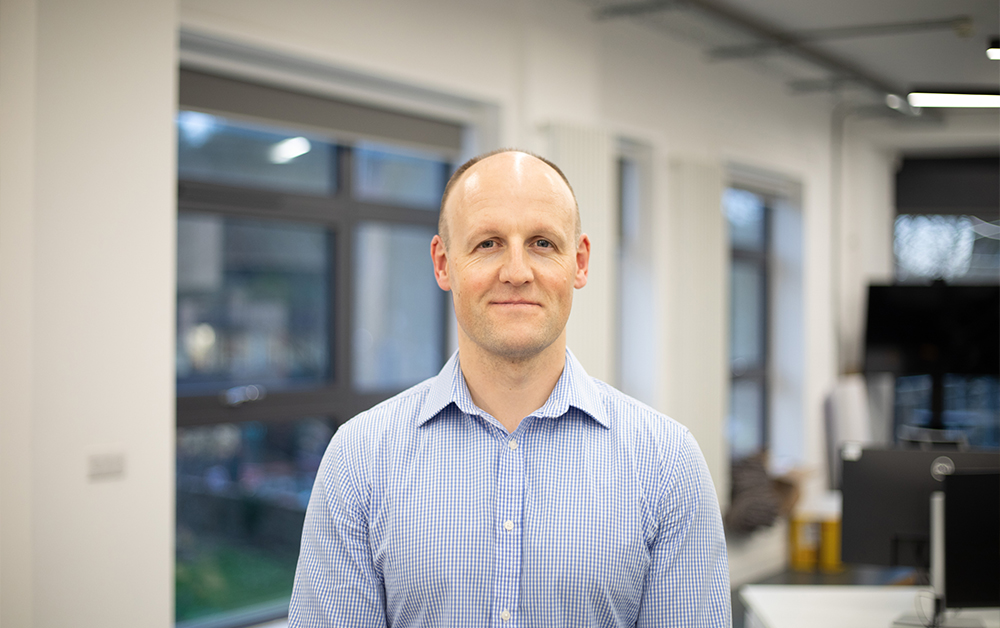12 Months Leading Crux: A Year in Review with Managing Director, Stephen Gilmore

A year ago, Stephen Gilmore stepped into the role of Managing Director at Crux, focused on three clear goals: global growth, creative excellence, and delivering ever greater value to clients.
His first 100 days set a bold pace, publishing a 20-theme strategic roadmap and establishing a physical presence in Massachusetts to formalise Crux’s expansion into the US. One year on, we check in with Stephen to reflect on what’s been achieved, what’s evolved, and how Crux is positioning itself for the next stage of impact.
In your first 100 days, you launched over 100 projects aligned to 20 strategic themes. Where do those stand today and how have they shaped Crux’s evolution?
That early sprint laid the groundwork for everything we’re building now. We made a list of ambitions and turned them into over 100 tangible projects, many of which are now well underway or completed. The US expansion was one such major project and was made up of a number of smaller projects. Rather than being regarded complete, this strategic project is now into its next phase of growth and maturity. The clarity of those 20 strategic themes helped align every part of the business, from our delivery teams to operations. Importantly, it’s helped people feel more connected to the bigger picture. As a leadership team, we’ve used that structure to track progress and make decisions more transparently. What’s emerged is a culture of continuous improvement where good ideas surface quickly, and the right support and resources follow.

You highlighted incorporation in Massachusetts as a milestone last year, how has your US expansion developed since then?
The expansion has moved quickly. Our site in Kendall Square puts us right in the centre of a thriving innovation community, and that’s already translating into meaningful partnerships. We’ve relocated key engineering and human factors experts to lead locally and ensure continuity in both culture and quality. On the ground, we’ve been building relationships with universities and investing in talent pipelines through programmes at MIT, Harvard and Tufts. As a result, recruitment has been strong, and momentum is building. We’ve also seen a noticeable uptick in client interest. Major award wins and speaking invitations at international conferences show that our already strong reputation is growing within our community. We’re already expanding our physical footprint in the US to meet demand, which tells us the move wasn’t just strategic, it was timely.
You spoke about ‘taking off old hats’ and changing perspective as a challenge. How has your leadership approach evolved over the past 12 months?
One of the biggest shifts has been letting go of old routines and staying open to new ways of engaging. I’ve stayed close to the work, but I’m more deliberate now about stepping back and allowing the wider team’s thinking to shape outcomes. The move into the MD role meant adjusting how I show up day to day, not just having a view on the work but listening carefully to how it’s landing across the organisation. I’ve also been much more focused on structure: building better reporting systems, clearer frameworks, and more direct ways for teams to raise feedback. It’s helped improve decision-making efficiency and sharpened our focus.
What standout achievements or turning points have defined this first full year for you as MD?
Establishing a permanent presence in the US was a defining moment. It took careful planning, but the impact has been immediate. That move unlocked new client relationships, brought in exciting new work and gave us a foothold in one of the world’s most influential innovation communities. Another big shift has been our internal transformation. This year has seen the spin-out of Life Sciences as its own function and seen the formation of Chief Engineer and Chief Scientist role. Within the same year we appointed Matt Jones as our new Engineering Director, bringing a wealth of experience and expertise to the team. We’ve built live dashboards across all functions, from Sales to HR to Operations. That visibility means better accountability and faster, smarter decisions. It’s also been great to see recognition of our client work at a global level, including innovation awards and published scientific collaborations with some of the industry’s most respected names.
Crux has committed to doubling in size by 2027. How are you balancing that growth ambition with maintaining the company’s culture and quality?
Growth only works if the culture stays strong and we maintain an uncompromising view on quality. That’s why we’ve focused on structure and communication early in this journey. From new reporting frameworks to company-wide updates and forums, we’ve built ways for people to stay informed and involved. I’ve prioritised time with our Quality and Operations teams to ensure we are building strong and scalable foundations to accommodate our growth ambitions. Our reviews are detailed and proactive, and they bring a high level of rigour to how we work across the board. As we expand internationally, we’re putting experienced people in place who embody the Crux values and culture, we are conscious to get that bit right from the start.
What progress have you made in diversifying beyond traditional sectors like drug delivery and consumer products?
With a physical US presence and permanent staffing, we are seeing existing long term client relationships thrive. Alongside the conventional, we are exposed to a wide array of novel technologies as we engage the local community and beyond. Crux have become a partner of choice to provide expert turnkey support to bring these exciting projects onto market. Our Life Sciences niche sits well within the novel technology space, where Crux can take bespoke toolsets and radical scientific approaches to support some of the most ambitious and innovative briefs.
Has the client perception of Crux changed over the past year and if so, how?
As I stepped into the MD role, it won’t have been missed that we triggered a rebrand, website relaunch and doubled down on promoting the Crux message at global conferences. Coupled with the launch of the US office, and expansion of our UK footprint, we are not surprised to hear clients reflect on the increased exposure, energy and dynamism surrounding the company. For clients new and old, we are frequently regarded as the company that “actively advances the science” and can couple expertise in human factors and usability, seamlessly woven into elegant industrial design, with best-in-class innovative engineering at its core. With bespoke technology solutions borne out of our electronics and software group and world class digital twin capability within our applied sciences team, Crux boast a formidable solution portfolio for even the toughest briefs.
What’s next for Crux? Are there any bold steps or new directions we should be watching for in the coming year?
We’ve set a clear ambition: to double the size of the business in the coming years. That means continuing to scale intentionally, without compromising the quality our clients rightly expect from the Crux brand. One of the biggest shifts has been in the US, where our operation is already growing faster than projected. We’ve begun expanding our real estate footprint in Kendall Square to meet demand, and the level of client engagement has been affirming. Behind the scenes, we’re also working on strengthening operational frameworks, compliance, and robustness, so the business can keep pace with the new scale.